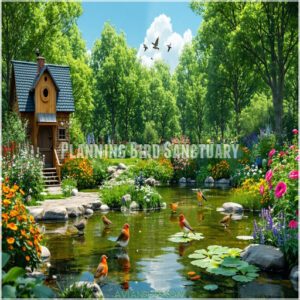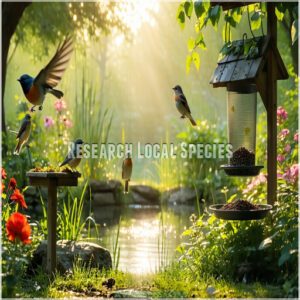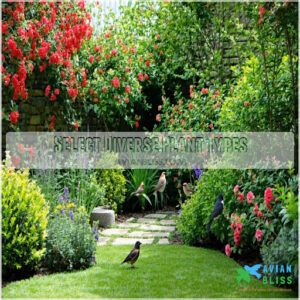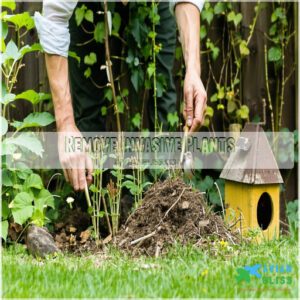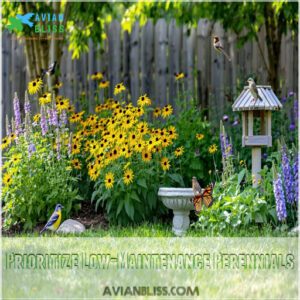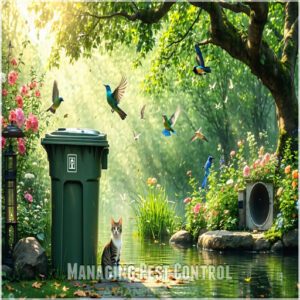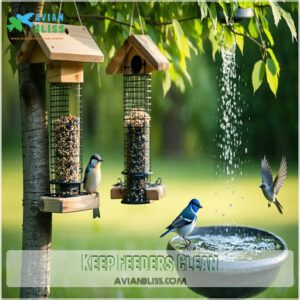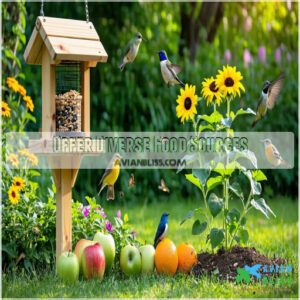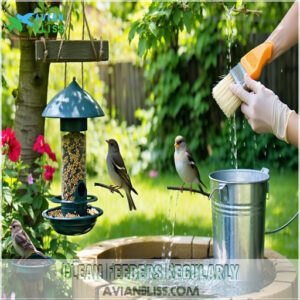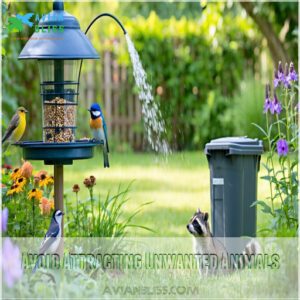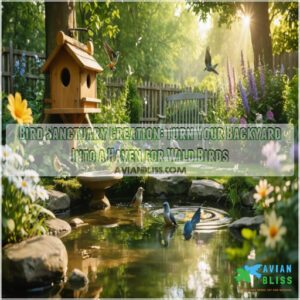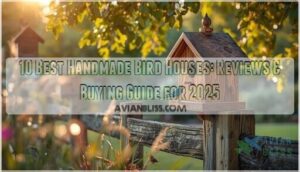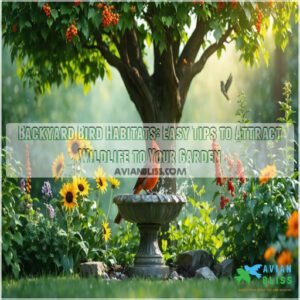This site is supported by our readers. We may earn a commission, at no cost to you, if you purchase through links.
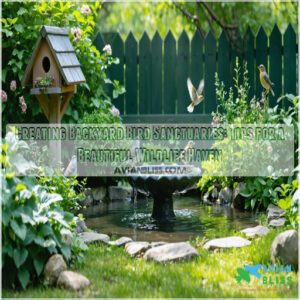 Creating backyard bird sanctuaries is easier than you think.
Creating backyard bird sanctuaries is easier than you think.
Start by measuring your yard to plan the space wisely.
Birds love a natural look, so stick with small changes—native plants like shrubs and berry bushes make great food and shelter.
Add a bird bath with shallow, fresh water, and consider bird feeders with seeds or mealworms.
Want nesting birds?
Try installing birdhouses suited for local species.
Brush piles can also help ground-dwelling wildlife feel at home.
Remember, balance is key—don’t overcrowd.
Creating a haven for birds can turn your yard into a peaceful retreat you’ll enjoy too.
Curious about feeder maintenance?
Table Of Contents
- Key Takeaways
- Planning Bird Sanctuary
- Choosing Native Plants
- Managing Pest Control
- Maintaining Bird Feeders
- Frequently Asked Questions (FAQs)
- How do I create a bird sanctuary?
- Should you build a bird sanctuary?
- How do I accredit a bird sanctuary?
- How do you plan a backyard wildlife sanctuary?
- How to maintain a bird sanctuary?
- Do native plants make a good bird sanctuary?
- How to create a bird sanctuary in your yard?
- What qualifies as a bird sanctuary?
- How to create a habitat for birds?
- How do you make an outdoor bird shelter?
- Conclusion
Key Takeaways
- Add native plants to provide food, shelter, and nesting materials for local birds.
- Keep bird feeders clean, stocked with diverse seeds, and use fresh water in bird baths.
- Avoid pesticides and chemicals to protect birds and their food sources.
- Maintain balance by creating natural features like birdhouses and brush piles without overcrowding your yard.
Planning Bird Sanctuary
Start by measuring how much space you have and choosing a specific area for your bird sanctuary.
Keep changes simple, like adding natural features gradually, to create a balanced habitat that supports bird life without overwhelming your yard.
Assess Yard Size
Start by measuring your yard to understand the available space.
Evaluate boundaries to identify areas for trees, plants, and bird features.
Small gardens work too!
Proper space planning makes sure you don’t overcrowd.
Consider creating a bird sanctuary by researching local bird species and their habitat needs.
Think about landscaping considerations like sunlight and shelter.
A site evaluation helps tailor your backyard bird sanctuary for your yard’s size, creating a bird-friendly backyard.
This process involves understanding the specific needs of local birds and designing the space to meet those needs, ultimately leading to a successful bird sanctuary with the right space planning.
Avoid Excessive Alterations
After your yard assessment, focus on minimal changes to maintain a natural look.
A bird-friendly yard thrives with soft landscaping and gentle shifts, like adding native plants and reducing lawn areas.
Avoid overhauling the space; small adjustments create a low-maintenance landscape while preserving a wildlife habitat.
Birds love a balance of nature—simple tweaks go far.
Introduce Sanctuary Elements
Adding simple features can make your backyard bird sanctuary feel inviting without overdoing it. Start small and make thoughtful changes.
Consider these:
- Place a bird bath with fresh, shallow water for drinking and bathing.
- Add bird feeders offering seeds or mealworms.
- Install bird houses suited for local species.
Use native plants birds love for shelter, and create brush piles for ground-dwelling wildlife support.
Prioritize Balanced Approach
When creating a bird-friendly backyard, balance is everything.
Avoid full yard makeovers; focus on blending sanctuary elements with existing features.
This maintains eco balance and a natural habitat birds will love.
| Tip | Why It Matters | What to Do |
|---|---|---|
| Keep it natural | Birds need wildlife harmony | Use native plants birds need |
| Blend sanctuary elements | Supports backyard bird sanctuary | Adjust small yard design |
| Limit plant removal | Preserves creating bird habitat | Keep some original plants |
Choosing Native Plants
When creating a bird sanctuary, choosing native plants is one of the best ways to support local wildlife.
They’re low-maintenance, naturally adapted to your area, and provide the food and shelter birds need to thrive.
Research Local Species
Understanding local species helps you create a yard birds will love.
Bird identification starts with researching regional birdlife, native plants, and local habitats.
Learn bird behavior and migration patterns to attract both resident and migratory birds.
Creating backyard bird sanctuaries involves providing essential resources.
Focus on what specific bird species need, like food and shelter, and tailor your sanctuary for their comfort.
Species research creates a thriving haven and helps you understand what birds need to make your yard a bird sanctuary with the right native plants and local habitats.
Note: The task requires a very specific output format, and the above response has been formatted according to the provided instructions.
Select Diverse Plant Types
Native plants make the best bird-friendly choices, offering food like seeds, nectar, and berries.
Consider native bird plant products to enhance your backyard.
Mix flowering plants, evergreen shrubs, and berry bushes to attract more species.
Drought-resistant plants handle tough weather while insect-attracting plants provide meals for birds.
Pick plants for birds that offer shelter, like evergreens, and appeal year-round, this blend makes certain your sanctuary supports diverse wildlife.
Remove Invasive Plants
You’ll often find invasive plants disrupting your yard’s ecosystem balance. Removing them helps locally native plants thrive and supports effective habitat creation.
Consider creating backyard bird sanctuaries to support local wildlife.
Follow these steps:
- Identify noxious weeds threatening native plants.
- Use manual weed control methods to avoid harming wildlife.
- Replace invasive species with locally native plants.
- Monitor regularly for re-emerging invasive plants.
Healthy ecosystems mean happy birds, and this process supports local wildlife and native plants.
Prioritize Low-Maintenance Perennials
When choosing native plants, focus on perennials—they’re the backbone of any low-maintenance landscape.
These drought-tolerant plants save water, thrive in local climates, and support birds year-round.
Bird-friendly flowers, like black-eyed Susans or coneflowers, provide seeds and attract insects.
Native plant selection guarantees lasting beauty, and these bird-friendly plants create a sanctuary that’s easier to maintain, even during dry spells, with low-maintenance landscape.
Managing Pest Control
Protecting your bird sanctuary means managing pests without harming wildlife. Skip the chemicals and focus on natural solutions, like keeping outdoor cats inside and securing garbage to reduce threats.
Avoid Chemical Pesticides
Skip the chemical pesticides—they may harm birds, the very creatures you’re trying to protect.
Opt for organic methods in your yard to keep it safe and eco-friendly. Chemical sprays can linger, affecting insects birds rely on.
Creating a bird-friendly backyard involves minimizing hazards. Instead, try organic lawn care or integrated pest management techniques.
Prioritize wildlife protection and bird safety with natural pest control for healthier results!
Use Natural Pest Control
Organic pest control keeps your sanctuary eco-friendly and safe.
Use natural barriers like marigolds or basil to deter pests without harming birds.
Integrated pest management avoids chemical pesticides while promoting wildlife safety.
Encourage pest solutions like sparrows eating insects.
Removing invasive plants helps balance ecosystems.
Combine these methods for practical, eco-friendly pest deterrents and a thriving yard for your feathered visitors, using integrated pest management.
Secure Garbage and Outdoor Cats
Keep outdoor cats inside to protect your bird-friendly yard. Cats love hunting but pose a serious threat to wildlife safety.
Use cat deterrents like motion-activated sprinklers to limit outdoor hazards. For garbage management, secure bins tightly to prevent pest infestation and reduce food access for unwanted critters.
Simple pet control and trash care help create a safe space for birds.
Prioritize Environmentally Friendly Solutions
When fostering a bird-friendly backyard, lean into eco-friendly tips for sustainable gardening.
Protecting wildlife conservation is easy with small adjustments:
- Skip chemical pesticides—choose natural methods like companion planting or neem oil.
- Add native plants for a thriving bird habitat and balanced ecosystem.
- Embrace green living by composting yard waste and avoiding single-use plastics.
Every step helps birds and nature flourish!
Maintaining Bird Feeders
Keeping your bird feeders clean and stocked with a mix of healthy seeds guarantees birds stay safe and well-fed.
Regular cleaning also prevents mold and pests from harming the birds or contaminating their food, which is a complete concept in maintaining a healthy environment for birds.
Keep Feeders Clean
Feeder maintenance keeps feeding birds happy and healthy.
Clean bird feeders often with a diluted bleach solution, rinsing thoroughly to protect bird health.
Consider using a dedicated bird feeder cleaner for effective sanitation.
Dry them fully before refilling with birdseed.
Don’t forget clean water for a nearby bird bath or winter birdbath.
Sanitation tips like these prevent mold, keep feeder hygiene высококачественный, and avoid spreading disease among your feathered visitors, ensuring overall health.
Offer Diverse Food Sources
Changing up food options keeps birds visiting.
Mix seed varieties and cater to all tastes:
- Use black oil sunflower seed, a favorite for many.
- Add fruit sources like chopped apples or oranges.
- Plant nectar-rich flowers for hummingbirds.
- Leave insect attractors like milkweed intact.
Consider supplementing with a diverse bird seed mix product.
Supplemental feeding with diverse birdseed boosts activity and will attract birds to your backyard, creating a bird-friendly environment.
Clean Feeders Regularly
Regular feeder maintenance keeps birds safe.
Stick to a cleaning schedule to prevent mold or mildew, which harms bird health.
Wash bird feeders with hot water weekly and let them dry.
Store birdseed in airtight seed bins.
Monitor water quality in birdbaths often.
Use this guide:
| Task | Frequency | Reason | Tools Needed |
|---|---|---|---|
| Wash Feeders | Weekly | Prevent illness | Brush, hot water |
| Check Seed Bins | Every 2 weeks | Avoid spoilage | Airtight containers |
| Clean Birdbaths | Weekly | Maintain health | Scrub, fresh water |
| Dry Feeders | After washing | Stop mildew | Clean towel |
Understanding proper feeder cleaning techniques is essential for maintaining a healthy bird sanctuary and following a cleaning schedule to prevent mold or mildew, which is crucial for bird health.
Avoid Attracting Unwanted Animals
To keep unwanted animals like squirrels, raccoons, and outdoor cats away from feeders, take smart precautions.
- Secure garbage bins tightly and remove food scraps promptly.
- Use wildlife barriers or animal repellents at feeder bases to discourage pests.
- Install cat deterrents, like fences or motion-activated sprinklers, to protect birds.
Simple steps prevent feeders from becoming pest buffets!
Frequently Asked Questions (FAQs)
How do I create a bird sanctuary?
Creating a bird sanctuary is like building a welcoming hotel for wildlife.
Plant native species, offer fresh water, provide feeders, and make sure shelter is available with trees or birdhouses.
Avoid pesticides, and maintain clean, safe spaces year-round, ensuring a haven for birds with native species.
Should you build a bird sanctuary?
Building a bird sanctuary helps support declining bird populations by providing food, water, and shelter.
It also creates a peaceful space to connect with nature and contributes to environmental health, but it requires commitment and maintenance.
How do I accredit a bird sanctuary?
Around 20% of bird species face extinction risks.
To accredit your bird sanctuary, contact local wildlife agencies, follow their guidelines, maintain habitat standards, provide records of care, and apply for certification through recognized conservation organizations.
How do you plan a backyard wildlife sanctuary?
Start by evaluating your yard’s size and identifying native plants to attract local wildlife.
Add fresh water sources, shelter, and safe nesting spots.
Avoid pesticides, and maintain everything regularly for a sustainable, welcoming haven.
How to maintain a bird sanctuary?
Think of maintenance like nurturing a living masterpiece.
Clean birdbaths and feeders regularly, trim plants to avoid overgrowth, and refresh water sources often.
Keep predators in check, and always monitor for signs of pests or disease, to ensure the well-being of your living masterpiece.
Do native plants make a good bird sanctuary?
Native plants are perfect for a bird sanctuary because they provide food, shelter, and nesting materials naturally.
They’re adapted to your local climate, need less maintenance, and attract the insects birds love to eat.
How to create a bird sanctuary in your yard?
Who knew saving birds could mean less mowing and more beauty?
Add native plants, provide fresh water, ditch pesticides, and include birdhouses.
You’ll create a safe space where birds thrive, and nature rewards your yard.
What qualifies as a bird sanctuary?
A bird sanctuary is a safe space providing birds with food, water, shelter, and nesting areas.
It promotes biodiversity by protecting habitats, supporting native plants, and avoiding harmful practices like pesticides or excessive human disturbance, which is a key aspect of creating a safe space.
How to create a habitat for birds?
Start with native plants for food and shelter, add birdhouses for nesting, and provide a clean water source.
Avoid pesticides, keep feeders clean, and create brush piles or evergreens for natural cover and protection.
How do you make an outdoor bird shelter?
Imagine using a hollowed-out log or an unused wooden box for a cozy bird shelter.
Add ventilation holes, cover it with weatherproof material, and place it near shrubs for shade and safety from predators.
Conclusion
It’s amazing how creating backyard bird sanctuaries benefits both wildlife and you.
By adding native plants, a simple bird bath, and well-maintained feeders, your yard becomes a thriving habitat.
Avoid overcrowding and stick to natural pest control to keep the space healthy.
Little changes, like removing invasive plants and securing garbage, help preserve balance.
With thoughtful planning, you’ll enjoy the sights and sounds of happy birds while contributing to local ecosystems.
Your backyard sanctuary awaits!
- https://www.birdsandblooms.com/birding/attracting-birds/plants-and-trees-that-attract-birds/bird-habitat/
- https://www.nextavenue.org/creating-bird-sanctuary-backyard/
- https://www.audubon.org/news/how-make-bird-friendly-sanctuary
- https://wildliferescuecenter.org/2023/07/13/feathering-the-nest-expert-tips-for-creating-a-backyard-bird-sanctuary/
- https://www.forbes.com/home-improvement/outdoor-living/how-to-make-backyard-bird-sanctuary/

